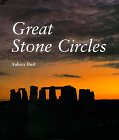<< Feature Articles >> Stone Rows. A practical solution
Submitted by Roger B Hutchins on Sunday, 23 October 2005 Page Views: 7978
Neolithic and Bronze AgeCountry: England County: Devon Type: Stone Row / AlignmentInternal Links:

Stone rows contain information of direction and distance. What is more, the row was never intended to be seen in isolation. If you follow the line suggested by the row, whether straight or with many changes in direction like The Upper Erme Row, further stones can be found through the distant landscape. Although most of these "way mark" stones have been removed for various reasons, enough remain in place to demonstrate that the stone row was a condensed representation of that way marked route.
The stone rows are (in my opinion) man's earliest attempts to measure and record geographical information. They are like linear maps. I will give two examples to demonstrate the case.
Hurston Ridge Stone Row is perhaps the best preserved and neatest designed row on Dartmoor. A line extended to the coast Northwards following the direction suggested by the row will hit Minehead, a sheltered haven and ancient port approximately 44 miles from the row. The length of the row given by Jeremy Butler (Dartmoor Atlas of Antiquities) is 143.3 meters. If we discount the distance to the centre of the circle, the actual row length from the most Southern stone to the most Northern stone is 142 meters.
At a scale of 500 to 1, 142 X 500= 713000 meters which is 77645.6 yards which is 44.1 miles.
This figure of 44.1 miles is so close to the distance to Minehead that it seems probable that it was intelligent design.
The upper Erme Stone Row is the longest row on record, and Jeremy Butler gives it as 3300 meters from the center of the circle to the summit cairn at the North end. If we deduct 100 meters for the distance fron the last stone to the cairn, and 7.9 meters for the distance from the centere of the circle to the first stone, the actual length of the stone row is reduced to 3192.1 meters.
Using a similar calculation as above, but a scale of 300 to 1, we get a distance of 595.036 miles. Following the route suggested by the row, which is not a straight line, the distance from the row to the North coast of Scotland is approximately 595 miles.
Is this design or coincidence?
What is even more convincing, is that if the row is divided into sections dividing each change in direction, the first being straight and nearly due North, the second curving to the East, the third North, the fourth veering to the West, the fifth veering to the East, the sixth continuing North to the coast. Each section at the same scale of 300 to1 fits the geography in terms of the best route from the row to the coast of Scotland.
The first straight section takes the traveller across the Seven Estuary to the Black Mountains, the second curving section to avoid Morcombe Bay, The third North to Carlisle, the fourth slightly West to Glasgow, the fifth to the great Glen the sixth North to the coast.
I have done similar calculations for many of the British stone rows, and have found that while some of them seem to be designed to record geographical information, others seem to be designed to guide travellers to coastal havens.
The massive alignments at Carnac were at first intimidating. I could not believe that such a huge enterprise could have a similar function as the British alignments. Whatever the intended function, the builders were thinking very big. It was only when I began to think big that I realised that our prehistoric ancestors had explored, measured and recorded in stone journeys from the most Westerly point of the Euro Asian land mass to the most Easterly point. These alignments fit the geography at a scale of 10000 to 1, so perfectly, that it has to be design and not coincidence.
Is it too hard to believe that people who were capable of huge engineering projects were also capable of exploring, measuring and recording their world?
All comments welcome. rogerbhutchins@hotmail.com
<< The Great Stone Circles - How they Work Part 9
Speaking for the Stones: Challenging Threats to a Hidden Legacy >>






 We would like to know more about this location. Please feel free to add a brief description and any relevant information in your own language.
We would like to know more about this location. Please feel free to add a brief description and any relevant information in your own language. Wir möchten mehr über diese Stätte erfahren. Bitte zögern Sie nicht, eine kurze Beschreibung und relevante Informationen in Deutsch hinzuzufügen.
Wir möchten mehr über diese Stätte erfahren. Bitte zögern Sie nicht, eine kurze Beschreibung und relevante Informationen in Deutsch hinzuzufügen. Nous aimerions en savoir encore un peu sur les lieux. S'il vous plaît n'hesitez pas à ajouter une courte description et tous les renseignements pertinents dans votre propre langue.
Nous aimerions en savoir encore un peu sur les lieux. S'il vous plaît n'hesitez pas à ajouter une courte description et tous les renseignements pertinents dans votre propre langue. Quisieramos informarnos un poco más de las lugares. No dude en añadir una breve descripción y otros datos relevantes en su propio idioma.
Quisieramos informarnos un poco más de las lugares. No dude en añadir una breve descripción y otros datos relevantes en su propio idioma.